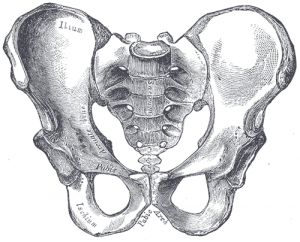Sacroiliac Joint: Difference between revisions
No edit summary |
No edit summary |
||
| Line 6: | Line 6: | ||
== Description == | == Description == | ||
The sacroiliac joint (simply called the SI joint) is the joint connection between the spine and the pelvis. It is a large diathrodial joint made up of the sacrum and the two innominates of the pelvis. Each innominate is formed by the fusion of the three bones of the pelvis: the ilium, ischium, and pubic bone. <ref>Dutton M. Orthopaedic Examination, Evaluation, and Intervention. 2nd ed. New York: McGraw Hill, 2008. </ref> | The sacroiliac joint (simply called the SI joint) is the joint connection between the spine and the pelvis. It is a large diathrodial joint made up of the sacrum and the two innominates of the pelvis. Each innominate is formed by the fusion of the three bones of the pelvis: the ilium, ischium, and pubic bone. <ref>Dutton M. Orthopaedic Examination, Evaluation, and Intervention. 2nd ed. New York: McGraw Hill, 2008. </ref> | ||
[[Image:Gray241.png|thumb|right|Sacroiliac joint]] | [[Image:Gray241.png|thumb|right|Sacroiliac joint]] | ||
== Motions Available == | == Motions Available == | ||
| Line 14: | Line 14: | ||
== Ligaments & Joint Capsule<br> == | == Ligaments & Joint Capsule<br> == | ||
== Muscles == | == Muscles == | ||
There are 35 muscles that attach to the sacrum or innominates which mainly provide stability to the joint rather than producing movements. | There are 35 muscles that attach to the sacrum or innominates which mainly provide stability to the joint rather than producing movements. | ||
| Line 54: | Line 55: | ||
*[http://www.rad.washington.edu/academics/academic-sections/msk/muscle-atlas/lower-body/tensor-fascia-lata Tensor fascia lata] | *[http://www.rad.washington.edu/academics/academic-sections/msk/muscle-atlas/lower-body/tensor-fascia-lata Tensor fascia lata] | ||
*Transversus abdominus | *Transversus abdominus | ||
== Specific Pathologies == | |||
There are many pathologies that could present at the site of the sacroiliac joint including: | |||
*sacroiliac tuberculosis | |||
*spondyloarthropathy | |||
*crystal and pyogenic arthropathies | |||
*groin pain | |||
*osteitis pubis | |||
*symphysis pubic dysfunction | |||
*osteoarthritis | |||
*stress fracture<br><br> | |||
== Special Tests == | |||
== Other Important Information == | == Other Important Information == | ||
Revision as of 22:37, 2 June 2009
Original Editor - Your name will be added here if you created the original content for this page.
Lead Editors - Your name will be added here if you are a lead editor on this page. Read more.
Description[edit | edit source]
The sacroiliac joint (simply called the SI joint) is the joint connection between the spine and the pelvis. It is a large diathrodial joint made up of the sacrum and the two innominates of the pelvis. Each innominate is formed by the fusion of the three bones of the pelvis: the ilium, ischium, and pubic bone. [1]
Motions Available[edit | edit source]
Ligaments & Joint Capsule
[edit | edit source]
Muscles[edit | edit source]
There are 35 muscles that attach to the sacrum or innominates which mainly provide stability to the joint rather than producing movements.
Muscles that attach to the sacrum or innominates:
- Adductor brevis
- Adductor longus
- Adductor magnus
- Biceps femoris - long head
- Coccygeus
- Erector spinae
- External oblique
- Gluteus maxiumus
- Gluteus medius
- Gluteus minimus
- Gracilis
- Iliacus
- Inferior gemellus
- Internal oblique
- Latissimus dorsi
- Levator ani
- Multifidus
- Obturator internus
- Obturator externus
- Pectineus
- Piriformis
- Psoas minor
- Pyramidalis
- Quadratus femoris
- Quadratus lumborum
- Rectus abdominis
- Rectus femoris
- Sartorius
- Semimembranosus
- Semitendonosus
- Sphincter urethrae
- Superficial transverse perineal ischiocavernous
- Superior gemellus
- Tensor fascia lata
- Transversus abdominus
Specific Pathologies[edit | edit source]
There are many pathologies that could present at the site of the sacroiliac joint including:
- sacroiliac tuberculosis
- spondyloarthropathy
- crystal and pyogenic arthropathies
- groin pain
- osteitis pubis
- symphysis pubic dysfunction
- osteoarthritis
- stress fracture
Special Tests[edit | edit source]
Other Important Information[edit | edit source]
Resources[edit | edit source]
Recent Related Research (from Pubmed)[edit | edit source]
Extension:RSS -- Error: Not a valid URL: Feed goes here!!|charset=UTF-8|short|max=10
References[edit | edit source]
References will automatically be added here, see adding references tutorial.
- ↑ Dutton M. Orthopaedic Examination, Evaluation, and Intervention. 2nd ed. New York: McGraw Hill, 2008.







